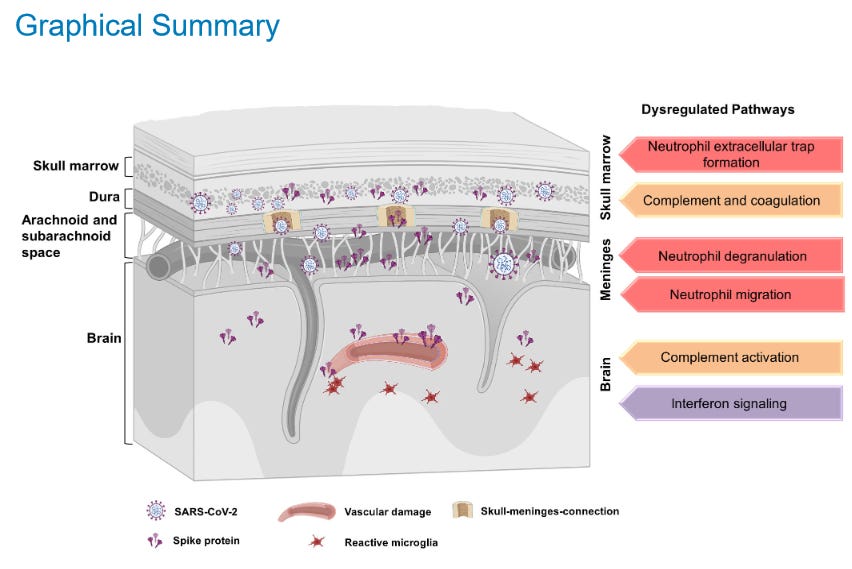SARS-CoV-2 Spike Protein Accumulates in the Skull and Brain, Potentially Leading to Neurological and Cognitive Dysfunction
Images Help Understand the Scope of the Problem
On April 5th, 2023, a group of scientists published a study about the "spike protein" from COVID-19 and how long it stays in the human body. They looked at mouse and human tissue using a special method and found the spike protein in bones and tissues around the brain could be there for a long time, even after a person has died from causes unrelated to COVID. The study also found that the spike protein was in other parts of the body, not just the head. It was in organs and bones throughout the body.
The study suggests that the spike protein might be able to infect the skull marrow and tissues around the brain before it gets into the brain itself. This is a different path from those presented before, and it offers another explanation as to why some people have long-term symptoms from COVID-19.
The scientists had a theory that if they looked at the skulls of people who died from non-COVID reasons, they might find something called "spike protein." So, they studied the skulls of 34 people who died from non-COVID reasons during the pandemic in 2021 and 2022. They found the spike protein in 10 of them. That's about 29% of people who have had COVID-19 in the past who might have this spike protein in their skulls for the rest of their lives.
These new findings suggest that the spike protein can stay in a person's head even after they have recovered from COVID-19. It also means that if someone gets infected multiple times, especially if they are exposed to a lot of the virus, they may have more spike proteins in their heads. This could increase the chances of having brain-related problems with each new infection.
Spike protein staining in human skull samples from COVID-19 patient and non-COVID-19 control patient

Representative images of spike protein and ACE2 staining in human lung tissue block
COVID can make people sick for a long time. People can experience a wide range of issues, and these issues are a result of organ damage and when the virus remains in organs or other body parts where the immune system is unable to remove it. Some people have reported problems with their brain, like feeling confused or having trouble thinking. Even people with mild cases of COVID can have damage to their brains. Scientists think that the virus might use different ways to get into the brain, like going through the blood vessels that go to the brain or being carried there by immune cells. It might get through if the blood-brain barrier is not working right, or if the virus travels along certain nerves that connect the nose and throat to the brain.
Long COVID symptoms can affect various organs and systems in the body, including the brain, and can cause serious complications. COVID is associated with changes in brain structure.
"a more pronounced loss of grey matter in crus II, part of the cognitive and olfactory-related lobule VII of the cerebellum"
The virus may enter the brain through different pathways, and scientists are still working on understanding the mechanisms of brain invasion by the virus so that they can develop effective treatments to prevent or mitigate the long-term complications of COVID-19.
T.A.C.T. is reporting the latest science, data, and analysis in order to achieve a sustainable path forward. Consider becoming a free or paid subscriber to help support this work.
Please share your thoughts and insights.








